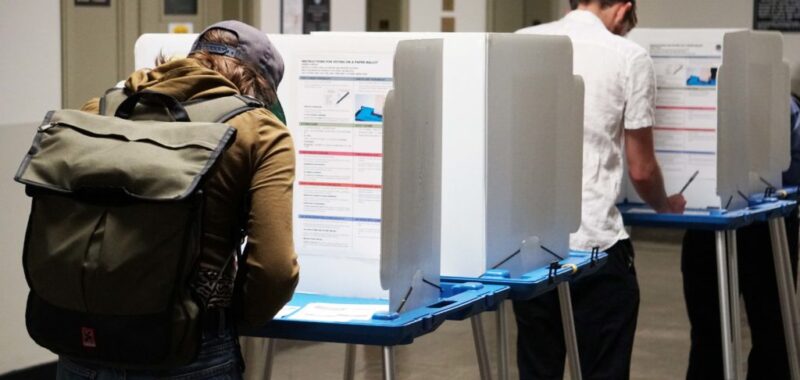Photo: Andrew Reed/EdSource
Every election cycle we hear about the challenges of getting certain groups of people to vote. This is particularly true of younger and more diverse voters who typically vote at rates well below other groups.
Often, the disconnect between these voters and the ballot box is caused by structural barriers; sometimes it has more to do with an absence of prioritization by candidates and campaign strategists.
Low turnout among younger and more multicultural voters not only reflects the troubled state of our democracy, but it also it stifles progress toward a society and economy that is more representative and more responsive to the needs of 21st century America. When these groups do turn out to vote, they tend to support more forward-looking policy positions that would help people and communities in need to achieve far greater economic security, including increased public investment in child care, education, affordable housing, and accessible transportation. When they don’t vote in proportion to their eligibility and interests, our democracy and societal well-being are the poorer for it.
Recognizing this, California cities like Oakland and Berkeley are beginning to support efforts to engage high school student voters as young as 16 and 17 years old, by enabling them to register and vote in local school board elections, beginning this fall. Other California cities should follow suit.
We know that voting is a habit. Once people start voting regularly, they continue to do so. Increasing voter turnout in the short run is essential to establish regular voting habits in the long run. In our current system, political campaigns are often tasked to lead get-out-the vote efforts by default, but campaigns are temporary and focused on winning elections, not stewarding a healthy democratic system. They are not designed to spend a lot of time and resources on hard-to-reach and hard-to-mobilize voters because the cost of turning out a likely voter is cheaper than the cost of turning out an unlikely voter.
Elections are all about who gets the most votes, and campaigns focus on the cheapest and easiest ways to get there. For that reason, low-propensity voters, like eligible high school and college students, are largely ignored. This is where nonprofit organizations can step in.
We’re seeing nonprofits playing an increasingly vital role in student’s lives — starting with out-of-school services like after-school programs, club sports, arts (like theater and dance), and camp activities. More and more now, nonprofits are involved with curricular support in areas where districts are short-staffed or just don’t have solid programs in specific areas of work (sometimes even embedding in the school-day offerings). Then, of course, there are myriad field trips and specific academic add-ons that are run by nonprofits in partnership with districts.
Research shows that turnout rates increase significantly when voters are encouraged to vote by nonprofit leaders they have relationships with, in a nonpartisan and active way. This kind of nonprofit engagement has been shown to make particularly significant improvements in turnout rates for young voters, voters of color and low-income voters.
Once turnout rates improve, campaigns start giving that category of voters more attention. This attention in turn engages voters further and encourages even higher turnout rates, creating a kind of virtuous engagement cycle. Census data indicates that about 80% of people who register to vote in a presidential election year actually go out and vote. This makes the next few weeks crucial for increasing turnout and creating new habitual voters during the 2024 cycle.
Recent research by political scientists and advocacy groups like NonprofitVOTE confirms that there are two things that nonprofits can do to increase voter turnout among their clients: Get them registered and then remind them to vote with a message that their vote matters and can make a difference. The message that “you matter” works a lot better in turning out disengaged youth voters than a policy message.
This is likely because they often assume that their vote will not have an impact on the election outcomes, so when a trusted source contacts them and tells them that their vote is important, it resonates.
So if your nonprofit can only do one thing this election season, make sure you encourage all eligible voters in your communities to get out and vote. Hearing from you that their voices are important can make a huge difference.
•••
Robb Smith is a political consultant, voting rights lawyer, and the author of the Margin of Error blog, a newsletter for progressives on polling, campaigns and election law.
Henry A. J. Ramos is a senior fellow at the Institute on Race, Power and Political Economy at The New School. They are co-authors of “Promoting Nonpartisan Multicultural Youth Get-Out-The-Vote Activities: A Guide for California Nonprofit Organizations,” produced by the California Explorations Project of The Institute on Race, Power and Political Economy.
The opinions expressed in this commentary represent those of the authors. EdSource welcomes commentaries representing diverse points of view. If you would like to submit a commentary, please review our guidelines and contact us.

